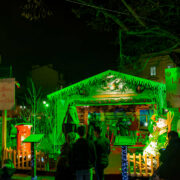
Palais Cardinal in Saint-Émilion: elegance and history
Have you ever dreamt of travelling back in time and exploring the majesty of Aquitaine? The Palais Cardinal de Saint Emilion, with its imposing architecture and aura of mystery, invites you to live a unique experience. In this article, we will take you through its corridors full of history, where every stone tells a fascinating story.
Discover how this emblematic palace has witnessed historical events and how today it remains a symbol of elegance and tradition. Also, don’t miss the opportunity to learn more about the free tour of Saint Emilion. This is an experience that will allow you to fully immerse yourself in the culture and charm of this special place.
From its vineyards to the legends hidden in its ramparts, the Palais Cardinal is a point of interest not to be missed. Get ready for a journey full of discovery, elegance and, of course, a good glass of wine. Read on and let yourself be seduced by the magic of Saint-Émilion!
First, let’s talk about Saint Emilion
When you arrive in a city for the first time, there is no better way to get to know it than by walking its streets and living closely with the locals. And this premise is magnified in Saint Emilion.
Its beautiful narrow streets, some of them cobbled, seem to have been trapped in time, and invite you to lose yourself in them and discover a secret or two. If this is your first visit, a wonderful alternative is to take advantage of a Saint Emilion excursion, which will take you to the main attractions of the place.
Here you can see the main monuments and even visit some of the most important vineyards, which are part of the itinerary on what to see in Saint Emilion and will make it clear from the first day why it is worth visiting Saint Emilion.
For many, Saint Emilion is part of their tour of pretty villages near Bordeaux. In addition to its natural beauty, where vineyards adorn the landscape and the friendliness of its inhabitants, the reality is that this is a place as peaceful as it is charming, with majestic buildings worth discovering. One of them: Palais Cardinal de Saint Emilion.
Why should you visit the Palais Cardinal?
The Palais Cardinal de Saint Emilion is a ruined Romanesque building. In fact, it is one of the oldest you can see in France.
You should know that the building, or what is left of it, is integrated into the old wall that protected and delimited the city. It is an extension of what was once the main entrance, known as the Wifey Gate.
Its construction dates back to the 14th century. At that time, the archbishop of Bordeaux, Bertrand de Goth, had it built for his nephew, Gaillard de la Mothe, who at that time received the title of Cardinal and lived in the building. He would later become Pope Clement V.
At the time of construction, the town was the second most important in the region after the capital, Bordeaux. It was normal for many aristocrats and members of the local bourgeoisie to have opulent and luxurious holiday homes here. In fact, this period is known as the golden century.
A bit of history
Cardinal Bertrand de Goth was in charge of the construction of the building, which has a strong Romanesque-Renaissance influence and a great deal of opulence. The palace, as he christened it, was originally known as the Archbishops’ Palace. In addition to its religious power, it also held political and diplomatic posts.
Although it is now in ruins, it is possible to see on its front wall the large arches that crowned the windows. They include geometric and floral style decorations all carved in stone. In fact, these windows are very similar to those of other buildings found in Saint Emilion, such as the collegiate church itself.
On both sides of the windows, there are two lines of perforated holes which suggest that there was a balcony in the past which was used to look out over the surrounding countryside. It also had a thick wooden cladding.
The main door is bricked up. In the past it was the only access to the moat, through which most of the goods that were later stored in the cellars of the building, such as wine barrels, passed.
You can still see what used to be the latrines with the pipes included. This is indicative of the level of comfort that the religious had at the time, considering that they were rare among the population.
Next to the façade of the Palais Cardinal Saint Emilion, you can see the old drawings. Among other things, they contain the Bourgeoise gate, which was destroyed towards the end of the 19th century for work on the rue des Grands Bans, which is now the city’s rue Guadet.
Being located so close to one of the main gates of the city and even forming part of the old city wall, it would suggest that it was a defensive construction.
However, according to some historians, it was rather an exhibition and a symbol of wealth, both for the citizens of Saint-Emilion and for the merchants and pilgrims who passed through.
Palais Cardinal over time
With the passage of time and due to the lack of inhabitants inside the Palais Cardinal, the building gradually fell into disrepair. Eventually, it lost much of its structure, as we have already mentioned, with only the front wall and the moat, which is the area where the latrines are located, remaining.
It is believed that, throughout history, this enclosure served as a venue for aristocratic receptions. In its day it was even attended by members of royalty and diplomats, bringing together the most select members of French society of the time.
If you are interested in visiting the palace or what remains of it, you can do so at any time, as it is open to the public and is right at the entrance to the city, next to the great wall.
Other nearby monuments
Near the Palais Cardinal Saint Emilion you can find other monuments that are well worth exploring, although to be honest, the whole city is a beauty you should see.
One example is the Monolithic Church, an underground building that was carved out of rock in the early 12th century. Apart from the curiosity of this type of construction, its gigantic proportions also stand out, 38 metres long and 12 metres high.



